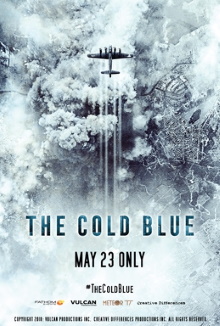Made from leftover footage of an older documentary and interviews with crewmembers who have survived to the present day, this is a film about the B-17 bomber missions that flew over Europe during the Second World War. Since we’ve all watched war movies, a lot of this feels very familiar but that are some anecdotes and key insights here that may be interesting even to those who have studied the subject. I especially appreciate how filmmaker Erik Nelson does of course acknowledge the crewmembers as war heroes but he also does not shy away from stating the bombing killed hundreds of thousands of civilians in Germany.
This film covers almost all aspects of the B-17 missions, noting in particular the very high casualty rate experienced by the crew. In particular one of the three cinematographers who captured the original images during the war was killed during a mission. As the survivors attest, they can in constant fear and keep precise count of the number of missions they are supposed to fly during each tour of duty, and are dismayed when the military arbitrarily increases the number due to its needs. In addition to the more expected dangers of enemy action in the form of flak from the ground and enemy fighters, they must contend with the extreme cold in the unpressurized and unheated planes and the high risk of mid-air collisions with friendly planes as more than a thousand are assembled into massive formations. There are all kinds of details to satisfy grognards, including how the bombs are loaded by a different ground crew entirely and how the bombs that remain the plane while they are way back must have their fuses carefully put back in as they risk exploding when the plane lands. The film stresses the incredible level of mutual trust and camaraderie that develops among the crew of each plane and also reveals that most of them don’t feel any guilt at all about the targets they drop the bombs on.
This documentary probably appeals mostly to those have an established interest in the subject. Filmmaker Erik Nelson was inspired to make this when he found the previously unknown archival footage leftover from the original documentary, and that of course is invaluable. But I think the narration and commentary that he collected from still surviving bomber crewmembers is just as important and there are so many anecdotes and stories there. For example, we all know how strong the bond among the soldiers of a unit are, but this may be especially so in a bomber crew of around ten people as they work exclusively with one another and don’t need to have close encounters with the enemy. Their strong feelings seem to extend to the B-17 planes as well as they were built to withstand incredible levels of damage and still be able to return to base. I liked the testimonies of how they develop superstitions to explain their survival after each mission, attributing their luck to all kinds of random things like whether or not they wore clean socks.
This being a modern film, Nelson does ask the crew members what they thought about the people they had bombed. Almost invariably, they reply that they never gave it a thought at all. I take that as a frank affirmation that it really is more difficult to think of the people you are killing as being real people when you’re so far removed from them and this is a problem that will only grow worse as we move to mostly using drones as weapons. I also like how the veterans all marvel at how young they were at the time and how impossible it would have been to get anyone even a little older to do the things that they did. As they note, the young simply have not yet developed a proper appreciation of their own mortality so they have not internalized how truly dangerous those bombing missions were. But I note that it is also easier to get the young to follow orders and act according to established procedures and processes without questioning why they’re doing these things. This surely contributed to why the crew members just went along when the air force switched missions from bombing military targets to bombing the civilian population.
Moral qualms aside, this film is full of satisfying detail and Nelson is to be commended for not shying away from tough questions even as he gives the proper amount of respect to the surviving veterans. Even if you already know all of the statistics beforehand, It does help to visualize the level of danger those crew members faced and the ridiculous amount of logistics involved in repairing and loading those planes up with bombs again after every mission. The film with a veteran hoping that young Americans will no longer need to do what they did but the fear is that the US military can now simply achieve that level of destruction with risking any American lives at all.
